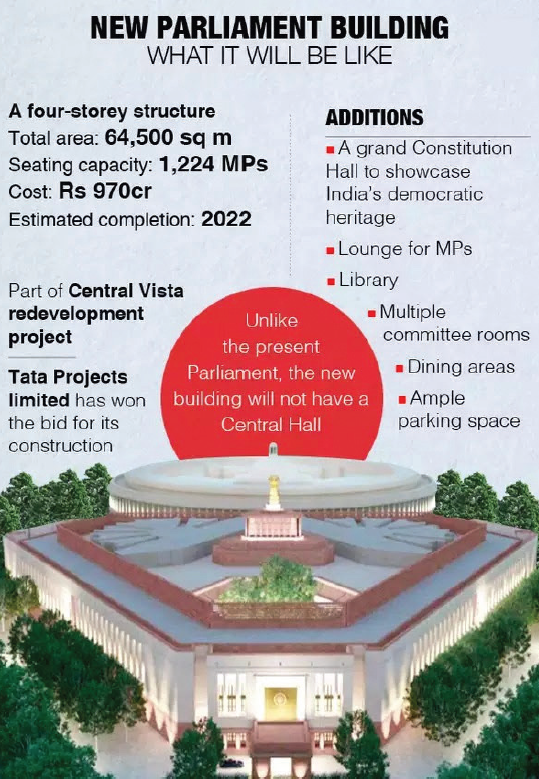Parliament also serves as a representation of the people and as the supreme legislative body to voice people’s concerns and opinion
By Geeta Singh
PM Narendra Modi inaugurated the newly built Parliament building on Sunday, 28 May by offering prayers as Hindu priests chanted religious hymns. However, most of the opposition parties (20 political parties) did not attend. They argued that President Draupadi Murmu, also our first-ever tribal head of State, should have inaugurated the Parliament House instead of the Prime Minister. On the other hand, BJP leaders say that during the Emergency, then Prime Minister Indira Gandhi laid the foundation stone of the Parliament Annexe building and Rajiv Gandhi laid the foundation stone of the Parliament Library building in 1987.
The tussle is yet another reminder of the strained relationship between the governing BJP and the opposition parties, who most recently protested the parliamentary disqualification of Rahul Gandhi, the de facto leader of the Congress Party. Another reason for opposition criticism was its inauguration date, which coincided with VD Savarkar’s birth anniversary.

This new Parliament House, built under the leadership of Narendra Modi, has replaced the Parliament House of the British era. The large, triangular building stands directly opposite the old, circular building on a two-mile-long path in the heart of the capital. The old Parliament dated back to 1927, has shown signs of distress and overuse. Apart from the shortage of space inside the Parliament House, there were several other challenges. In 2012, the Speaker, Meira Kumar, stated that the Parliament building was “weeping,” and approved a high-powered committee to look for an alternative complex. In 2015, the Speaker, Sumitra Mahajan, wrote to the Minister for Urban Affairs to have a new Parliament building with modern facilities.
The Old Parliament House, designed by British architects Sir Edwin Lutyens and Herbert Baker as ‘Council House’, had 543 Lok Sabha seats and 250 Rajya Sabha seats. It took six years (1921-1927) to build it. Then 83 lakh rupees were spent on its construction while today about 970 crore rupees have been spent on the construction of the new building. It will accommodate 888 and 552 seats, allowing for greater representation in Parliament in light of India’s growing population.
The new Parliament is an important part of the “Central Vista Project”, designed by architect Bimal Patel, which intends to revamp architecturally the 46 hectares in the political heart of New Delhi, which encompasses British colonial-era monuments and government buildings, including Sansad Bhavan (Parliament House), the Rashtrapati Bhavan (formerly the Viceroy’s House), and the Secretariat Buildings.
In addition to giving the buildings a facelift, the project cements Modi’s vision of a new, “self-reliant” India emerging from colonial shadows. Some have argued that it is also an effort to demonstrate a ‘New India’: “a country capable of maintaining its ancient heritage and restoring its spiritual and cultural glory while simultaneously making advancements towards its modern aspirations.”
Political analysts point out that the connection between Modi and architecture isn’t unique to India—it is a common feature of right-wing, populist leaders. In Turkey (Türkiye), President Recep Tayyip Erdogan has built new mosques all over the country, including the Grand Camlica Mosque in Istanbul. In Hungary, Prime Minister Viktor Orban reconstructed the 19th-century Castle District to make it the government seat.
Jan-Werner Müller, a professor of politics at Princeton University, wrote in Foreign Policy, “Populism is not primarily about the symbolic conquest of urban space, but it is about developing strategies—often literally—to cement an image of the “real people.” It has largely been forgotten that US President Donald Trump, in the dying days of his administration, had issued an executive order that would have required all new federal buildings to be constructed in classical style.
The new Parliament is very different from its older version in many ways. The Lok Sabha has been designed on the theme of the national bird peacock and the Rajya Sabha on the theme of the national flower lotus. The unique feature of the newly constructed Sansad Bhavan is that it has carpets from Mirzapur in Uttar Pradesh, bamboo floors from Tripura and stone carvings from Rajasthan. And the historical Scepter (Sengol) made of silver and gold plates belonging to Tamil Nadu on the right side of the Lok Sabha Speaker’s Chair installed by PM Modi. The materials used in the construction of the new Parliament House were sourced from different parts of the country. Teak wood was brought from Nagpur in Maharashtra, green stone from Udaipur, red granite from Lakha near Ajmer and white marble from Ambaji in Rajasthan. The red and white sandstone comes from Sarmathura in Rajasthan. All of these reflect diversity. Sarmathura is the place where sandstone for the Red Fort and Humayun’s Tomb was brought during the Mughal period.
However, despite valid grievances, this historic moment should not be overshadowed by the opposition. The bitterness between the government and the opposition has already made Parliament’s meaningful functioning extremely difficult and dealt a major blow to democracy. This is because democracy is not about buildings and statues but about discussions and finding common ground.
